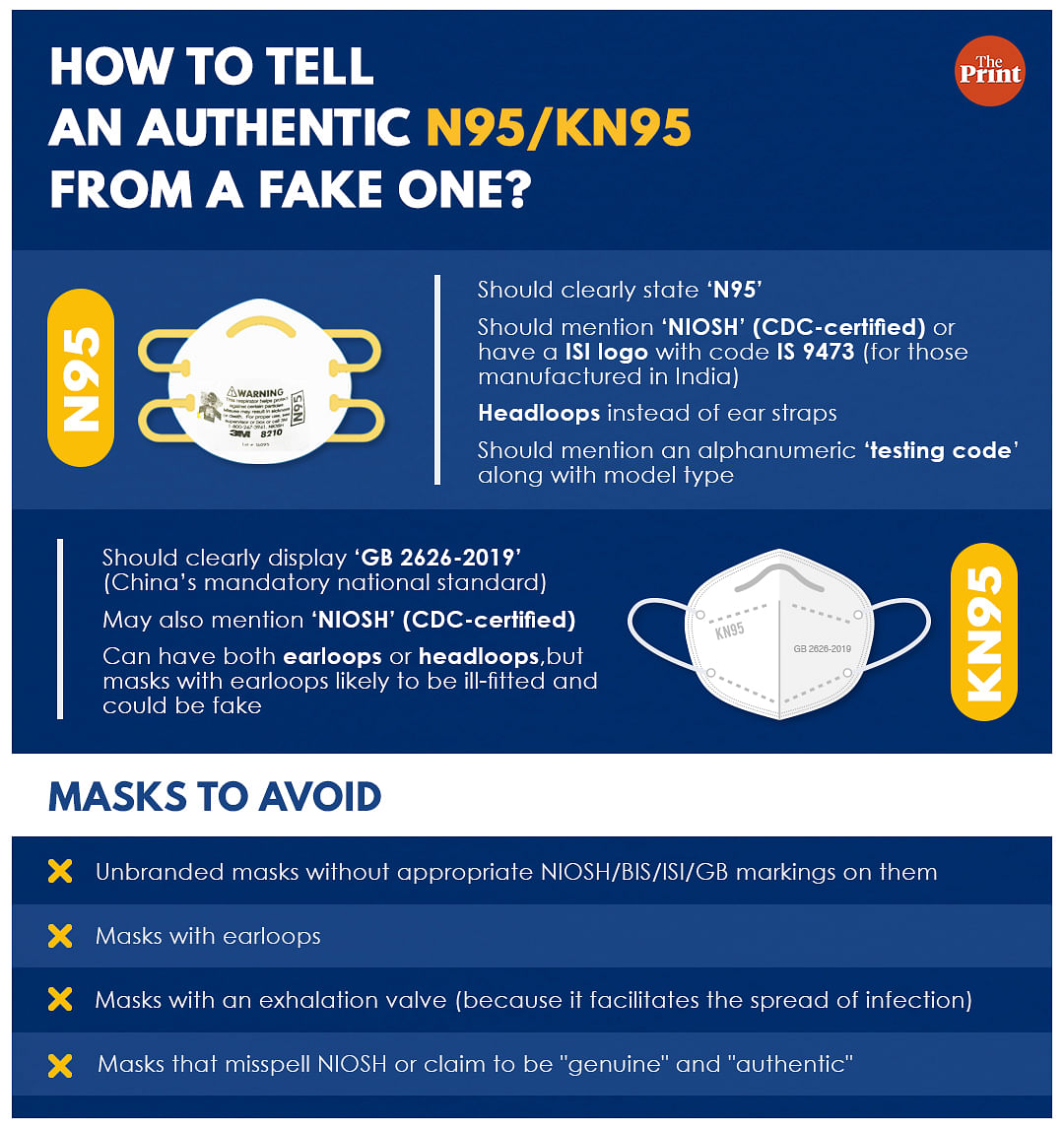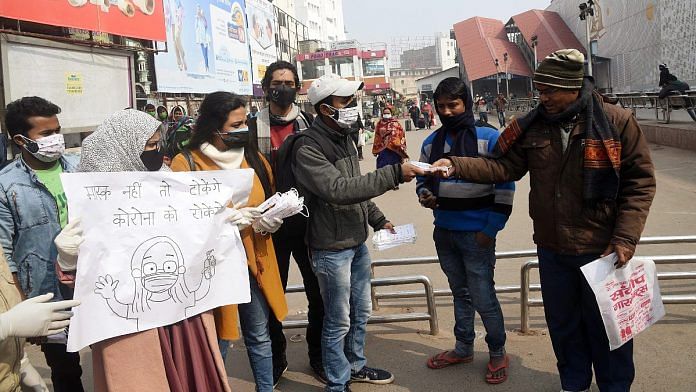New Delhi: The sharp rise in Covid-19 cases has brought with it familiar concerns from the first and second waves of the pandemic, about what precautions to take to avoid catching the infection.
With the Omicron variant doing the rounds, India recorded 3,17,532 new cases on 19 January, according to health ministry data.
Mandatory mask wearing is the foremost precaution listed in the Ministry of Health and Family Welfare’s detailed guidelines on Covid-19-appropriate behaviour in common and public spaces such as workplaces, restaurants and gyms.
While the market is flooded with various types of masks, the government’s guidelines do not specify which masks are appropriate for what settings, or how to spot counterfeit products.
Experts have recommended that given the high transmissibility of the Omicron variant of the coronavirus, N95 masks are much more effective, compared to surgical masks, as they drastically reduce transmission.
ThePrint explains what to look out for when buying a mask and why.
Also Read: Not just RT-PCR tests, now your ‘smart’ masks will also tell you if you have Covid-19
N95, KN95, FFP2 — What’s the difference?
‘N95’ is the most commonly marketed term to refer to masks that can filter out 95 per cent of harmful particulate matter in the air. These masks are recommended for maximum protection against viruses, bacteria and pollution because of the volume of pollutants and microbes they can filter out.
The term ‘N95’, however, actually refers to an American certification standard for this particular respirator. ‘KN95’ and ‘FFP2’ masks perform the same function of filtering out 95 per cent of particles, but are certified in different countries — the former in China and the latter in Europe.
“In India, we have our own standard for these masks, which is decided by the Bureau of Indian Standards (BIS). They have a checklist of requirements that the mask must fulfil, and it has to be tested before it is licensed for manufacture,” Prashant Agarwal, managing partner of Parko Abrasives, a Delhi-based company manufacturing N95 masks, told ThePrint.
The BIS’s standard for respirators that filter out 95 per cent of pollutants is ‘IS 9473’. These masks are made up of four to five layers of at least three types of material — non-woven fabric, a melt-blown filter, and hot air cotton.
“These masks are tested in a laboratory without human intervention. The BIS has standards to test for clogging, cleaning and disinfection, and checks on the fabrics used,” said Tarun Goyal, founder of Oxyguard Ventures, another N95 mask manufacturer.
“There’s no visual difference between N95 and KN95 masks. The only difference is between the testing methods and standards from different countries,” he added.
How to check a mask’s authenticity
At first glance, it is difficult to ascertain whether an N95 mask is authentic or inauthentic, but there are some markings that one can look for.
N95 masks approved by the US Centers for Disease Control and Prevention (CDC) in the US must be clearly labeled ‘NIOSH’, which stands for National Institute for Occupational Safety & Health — a research agency focused on the study of worker safety. They must also carry an alphanumeric testing code and model type, which should be clearly visible.
Legitimate N95 masks will also have elastic headloops as opposed to the more popularly available earloops, since they are supposed to form a tight seal around the nose and mouth.
Some CDC-approved N95 masks are available in India too. Brands like 3M and Honeywell offer ‘NIOSH’-marked N95 masks.
“Any N95 mask that claims to be reusable is also likely to be fake, since the melt-blown filters inside the mask will be destroyed with a wash,” said Agarwal of Parko Abrasives, adding: “Generally, you should not repeatedly use N95 masks, but they can be worn for up to five days at a time before discarding.”

In 2020, the Chinese government made it mandatory for KN95 masks to clearly display the marking ‘GB 2626-2019’ to show that they meet the new Chinese standards. Authentic KN95s can have both earloops and headloops, but those found in the market are more likely to have earloops, which could be a red flag since they will be ill-fitted. The CDC has reportedly found that 60 per cent of KN95s in the American market were fake.
Authentic FFP2 masks must also clearly say ‘FFP2’ with a ‘CE’ mark and four-digit code.
Indian manufacturers complying with the BIS’s standards can use the standard ISI (Indian Standards Institution) logo on products that have been licensed, along with a code number (IS 9473 in this case). Products without a ‘NIOSH’ or ‘BIS’ mark have not been approved by either body and may be inauthentic.
Misspelled markings are an obvious indication that a mask is not according to standards. Moreover, masks with exhalation valves should be avoided as they facilitate the spread of infection, according to the CDC.
The US CDC has a list of authentic mask makers on its website and makes it mandatory for certified manufacturers to mark their products accordingly. The Ministry of Textiles in India, too, has a list of approved manufacturers of N95 and FFP2 masks on its website.
On double-masking
On double-masking, the CDC recommends pairing a surgical mask with a cloth mask to improve fit and filtration, with the surgical mask underneath. It warns that wearing two surgical masks is unhelpful, and also does not recommend pairing a surgical mask with a KN95 or N95 mask.
(Edited by Gitanjali Das)
Also Read: Raipur worst, Delhi bad, Mumbai best in mask-wearing amid Covid surge, finds think-tank study



